Effects of Seismogenic Faults on the Predictive Mapping of Probability to Earthquake-Triggered Landslides
Abstract
:1. Introduction
2. Brief Description of the 2013 Lushan Earthquake
3. Method and Data
3.1. Logistic Regression Model
3.2. Landslide Inventory of the 2013 Lushan Earthquake
3.3. Influence Factors
4. Results and Analyses
4.1. Sampling Strategy
4.2. LR Analysis
4.3. Mapping Landslide Probability
4.4. Evaluation of Mapping Results from LR Analysis
5. Discussion
6. Conclusions
Author Contributions
Funding
Acknowledgments
Conflicts of Interest
References
- Keefer, D.K. Landslides caused by earthquakes. Geol. Soc. Am. Bull. 1984, 95, 406–421. [Google Scholar] [CrossRef]
- Xu, C.; Xu, X.W.; Yao, X.; Dai, F.C. Three (nearly) complete inventories of landslides triggered by the May 12, 2008 Wenchuan Mw 7.9 earthquake of China and their spatial distribution statistical analysis. Landslides 2014, 11, 441–461. [Google Scholar] [CrossRef]
- Kargel, J.S.; Leonard, G.J.; Shugar, D.H.; Haritashya, U.K.; Bevington, A.; Fielding, E.J.; Fujita, K.; Geertsema, M.; Miles, E.S.; Steiner, J.; et al. Geomorphic and geologic controls of geohazards induced by Nepal’s 2015 Gorkha earthquake. Science 2016, 351, aac8353. [Google Scholar] [CrossRef] [PubMed]
- Tian, Y.; Xu, C.; Ma, S.; Xu, X.; Wang, S.; Zhang, H. Inventory and Spatial Distribution of Landslides Triggered by the 8th August 2017 MW 6.5 Jiuzhaigou Earthquake, China. J. Earth Sci. 2019, 30, 206–217. [Google Scholar] [CrossRef]
- Xu, C.; Ma, S.; Tan, Z.; Xie, C.; Toda, S.; Huang, X. Landslides triggered by the 2016 Mj 7.3 Kumamoto, Japan, earthquake. Landslides 2018, 15, 551–564. [Google Scholar] [CrossRef]
- Roback, K.; Clark, M.K.; West, A.J.; Zekkos, D.; Li, G.; Gallen, S.F.; Chamlagain, D.; Godt, J.W. The size, distribution, and mobility of landslides caused by the 2015 Mw7.8 Gorkha earthquake, Nepal. Geomorphology 2018, 301, 121–138. [Google Scholar] [CrossRef]
- Xu, C.; Xu, X.; Shyu, J.B.H. Database and spatial distribution of landslides triggered by the Lushan, China Mw 6.6 earthquake of 20 April 2013. Geomorphology 2015, 248, 77–92. [Google Scholar] [CrossRef] [Green Version]
- Jessee, M.A.N.; Hamburger, M.W.; Allstadt, K.; Wald, D.J.; Robeson, S.M.; Tanyas, H.; Hearne, M.; Thompson, E.M. A Global Empirical Model for Near-Real-Time Assessment of Seismically Induced Landslides. J. Geophys. Res. Earth Surf. 2018, 123, 1835–1859. [Google Scholar] [CrossRef]
- Bai, S.-B.; Wang, J.; Lü, G.-N.; Zhou, P.-G.; Hou, S.-S.; Xu, S.-N. GIS-based logistic regression for landslide susceptibility mapping of the Zhongxian segment in the Three Gorges area, China. Geomorphology 2010, 115, 23–31. [Google Scholar] [CrossRef]
- Xu, C.; Xu, X.; Dai, F.; Saraf, A.K. Comparison of different models for susceptibility mapping of earthquake triggered landslides related with the 2008 Wenchuan earthquake in China. Comput. Geosci. 2012, 46, 317–329. [Google Scholar] [CrossRef]
- Tanyas, H.; Rossi, M.; Alvioli, M.; Van Westen, C.J.; Marchesini, I. A global slope unit-based method for the near real-time prediction of earthquake-induced landslides. Geomorphology 2019, 327, 126–146. [Google Scholar] [CrossRef]
- Ercanoglu, M.; Kasmer, O.; Temiz, N. Adaptation and comparison of expert opinion to analytical hierarchy process for landslide susceptibility mapping. Bull. Int. Assoc. Eng. Geol. 2008, 67, 565–578. [Google Scholar] [CrossRef]
- Reichenbach, P.; Rossi, M.; Malamud, B.D.; Mihir, M.; Guzzetti, F. A review of statistically-based landslide susceptibility models. Earth-Sci. Rev. 2018, 180, 60–91. [Google Scholar] [CrossRef]
- Xu, C.; Dai, F.; Xu, X.; Lee, Y.H. GIS-based support vector machine modeling of earthquake-triggered landslide susceptibility in the Jianjiang River watershed, China. Geomorphology 2012, 145, 70–80. [Google Scholar] [CrossRef]
- Vorpahl, P.; Elsenbeer, H.; Märker, M.; Schröder, B.; Maerker, M. How can statistical models help to determine driving factors of landslides? Ecol. Model. 2012, 239, 27–39. [Google Scholar] [CrossRef]
- Kavzoglu, T.; Sahin, E.K.; Colkesen, I. An assessment of multivariate and bivariate approaches in landslide susceptibility mapping: A case study of Duzkoy district. Nat. Hazards 2015, 76, 471–496. [Google Scholar] [CrossRef]
- Hong, H.; Pradhan, B.; Xu, C.; Bui, D.T. Spatial prediction of landslide hazard at the Yihuang area (China) using two-class kernel logistic regression, alternating decision tree and support vector machines. Catena 2015, 133, 266–281. [Google Scholar] [CrossRef]
- Cao, J.; Zhang, Z.; Wang, C.; Liu, J.; Zhang, L. Susceptibility assessment of landslides triggered by earthquakes in the Western Sichuan Plateau. Catena 2019, 175, 63–76. [Google Scholar] [CrossRef]
- Nowicki, M.A.; Wald, D.J.; Hamburger, M.W.; Hearne, M.; Thompson, E.M. Development of a globally applicable model for near real-time prediction of seismically induced landslides. Eng. Geol. 2014, 173, 54–65. [Google Scholar] [CrossRef]
- Shao, X.; Ma, S.; Xu, C.; Zhang, P.; Wen, B.; Tian, Y.; Zhou, Q.; Cui, Y. Planet Image-Based Inventorying and Machine Learning-Based Susceptibility Mapping for the Landslides Triggered by the 2018 Mw6.6 Tomakomai, Japan Earthquake. Remote Sens. 2019, 11, 978. [Google Scholar] [CrossRef]
- Xu, C.; Xu, X.; Dai, F.; Wu, Z.; He, H.; Shi, F.; Wu, X.; Xu, S. Application of an incomplete landslide inventory, logistic regression model and its validation for landslide susceptibility mapping related to the May 12, 2008 Wenchuan earthquake of China. Nat. Hazards 2013, 68, 883–900. [Google Scholar] [CrossRef]
- Li, W.-L.; Huang, R.-Q.; Xu, Q.; Tang, C. Rapid susceptibility mapping of co-seismic landslides triggered by the 2013 Lushan Earthquake using the regression model developed for the 2008 Wenchuan Earthquake. J. Mt. Sci. 2013, 10, 699–715. [Google Scholar] [CrossRef]
- Budimir, M.E.A.; Atkinson, P.M.; Lewis, H.G. A systematic review of landslide probability mapping using logistic regression. Landslides 2015, 12, 419–436. [Google Scholar] [CrossRef] [Green Version]
- Xu, C.; Xu, X.; Yu, G.J.L. Landslides triggered by slipping-fault-generated earthquake on a plateau: An example of the 14 April 2010, Ms 7.1, Yushu, China earthquake. Landslides 2013, 10, 421–431. [Google Scholar] [CrossRef]
- Kamp, U.; Growley, B.J.; Khattak, G.A.; Owen, L.A. GIS-based landslide susceptibility mapping for the 2005 Kashmir earthquake region. Geomorphology 2008, 101, 631–642. [Google Scholar] [CrossRef]
- Xu, C.; Shyu, J.B.H.; Xu, X. Landslides triggered by the 12 January 2010 Port-au-Prince, Haiti, Mw = 7.0 earthquake: visual interpretation, inventory compiling, and spatial distribution statistical analysis. Nat. Hazards Earth Syst. Sci. 2014, 14, 1789–1818. [Google Scholar] [CrossRef] [Green Version]
- Gorum, T.; Carranza, E.J.M.; Carranza, E.J. Control of style-of-faulting on spatial pattern of earthquake-triggered landslides. Int. J. Environ. Sci. Technol. 2015, 12, 3189–3212. [Google Scholar] [CrossRef]
- Burchfiel, B.C.; Zhiliang, C.; Yupinc, L.; Royden, L.H. Tectonics of the Longmen Shan and Adjacent Regions, Central China. Int. Geol. Rev. 1995, 37, 661–735. [Google Scholar] [CrossRef]
- Yong, L.; Allen, P.A.; Densmore, A.L.; Qiang, X. Evolution of the Longmen Shan Foreland Basin (Western Sichuan, China) during the Late Triassic Indosinian Orogeny. Basin Res. 2003, 15, 117–138. [Google Scholar] [CrossRef]
- Xu, X.; Wen, X.; Han, Z.; Chen, G.; LI, C.; Zheng, W.; Zhang, S.; Ren, Z.; Xu, C.; Tan, X.; et al. lushan Ms7.0 earthquake: A blind reserve-fault earthquake. Chin. Sci. Bull. 2013, 58, 1887. [Google Scholar] [CrossRef]
- Deng, Q.D. Chinese Active Tectonic Map; Seismological Press: Beijing, China, 2007. [Google Scholar] [CrossRef]
- Bai, S.-B.; Lu, P.; Wang, J. Landslide susceptibility assessment of the Youfang catchment using logistic regression. J. Mt. Sci. 2015, 12, 816–827. [Google Scholar] [CrossRef]
- Bertolini, G.; D’Amico, R.; Nardi, D.; Tinazzi, A.; Apolone, G. One model, several results: The paradox of the Hosmer-Lemeshow goodness-of-fit test for the logistic regression model. J. Epidemiol. Biostat. 2000, 5, 251–253. [Google Scholar] [PubMed]
- Chang, M.; Tang, C.; Li, W.-l.; Zhang, D.D.; Jia, T.; Ma, G.H.; Zhou, Z.Y. Image interpretation and spatial analysis of geohazards induced by “4.20” Lushan earthquake in epicenter area. J. Chengdu Univ. Technol. (Sci. Technol. Ed.) 2013, 40, 275–281. [Google Scholar] [CrossRef]
- Su, F.H.; Cui, P.; Zhang, J.; Gan, G.B. Rockfall and landslide susceptibility assessment in Lushan earthquake region. J. Mt. Sci. 2013, 31, 502–509. [Google Scholar]
- Zhang, J.; Su, F.; Fan, J. Distribution of landslides and collapses induced by 2013 “4.20” Lushan earthquake and hazards assessment: A case study of S210 highway. J. Mt. Sci. 2013, 31, 616–623. [Google Scholar]
- Ma, S.; Xu, C. Assessment of co-seismic landslide hazard using the Newmark model and statistical analyses: A case study of the 2013 Lushan, China, Mw6.6 earthquake. Nat. Hazards 2019, 96, 389–412. [Google Scholar] [CrossRef]
- Tian, Y.; Huang, X.; Ma, J.; Chen, X.; Xu, C.; Xu, X.; Shen, L.; Yao, Q.; Ma, S. Two comparable earthquakes produced greatly different coseismic landslides: The 2015 Gorkha, Nepal and 2008 Wenchuan, China events. J. Earth Sci. 2016, 27, 1008–1015. [Google Scholar] [Green Version]
- Xu, C.; Xu, X. Statistical analysis of landslides caused by the Mw 6.9 Yushu, China, earthquake of April 14, 2010. Nat. Hazards 2014, 72, 871–893. [Google Scholar] [CrossRef]
- Yi, G.; Long, F.; Amaury, V.; Yann, K.; Liang, M.; Wang, S. Focal mechanism and tectonic deformation in the seismogenic area of the 2013 Lushan earthquake sequence, southwestern China. Chin. J. Geophys. 2016, 59, 3711–3731. [Google Scholar] [CrossRef]
- Du, F.; Feng, L.; Ruan, X.; Yi, G.; Yue, G.; Zhao, M.; Zhang, Z.; Qiao, H.; Wang, Z.; Wu, J. The M7.0 Lushan earthquake and the relationship with the M8.0 Wenchuan earthquake in Sichuan, China. Chin. J. Geophys. 2013, 56, 1772–1783. [Google Scholar]
- Wang, W.; Hao, J.L.; Yao, Z.X. Preliminary result for rupture process of Apr. 20, 2013, Lushan Earthquake, Sichuan, China. Chin. J. Geophys. 2013, 56, 1412–1417. [Google Scholar] [CrossRef]
- Li, Y.; Jia, D.; Wang, M.; Shaw, J.H.; He, J.; Lin, A.; Xiong, L.; Rao, G. Structural geometry of the source region for the 2013 Mw 6.6 Lushan earthquake: Implication for earthquake hazard assessment along the Longmen Shan. Earth Planet. Sci. Lett. 2014, 390, 275–286. [Google Scholar] [CrossRef]
- Li, J.; Liu, C.; Zheng, Y.; Xiong, X. Rupture process of the M s 7.0 Lushan earthquake determined by joint inversion of local static GPS records, strong motion data, and teleseismograms. J. Earth Sci. 2017, 28, 404–410. [Google Scholar] [CrossRef]
- Aditian, A.; Kubota, T.; Shinohara, Y. Comparison of GIS-based landslide susceptibility models using frequency ratio, logistic regression, and artificial neural network in a tertiary region of Ambon, Indonesia. Geomorphology 2018, 318, 101–111. [Google Scholar] [CrossRef]
- Gallen, S.F.; Clark, M.K.; Godt, J.W. Coseismic landslides reveal near-surface rock strength in a high-relief, tectonically active setting. Geology 2015, 43, 11–14. [Google Scholar] [CrossRef]
- Zhu, J.; Daley, D.; Baise, L.G.; Thompson, E.M.; Wald, D.J.; Knudsen, K.L. A Geospatial Liquefaction Model for Rapid Response and Loss Estimation. Earthq. Spectra 2015, 31, 1813–1837. [Google Scholar] [CrossRef]
- Cantarino, I.; Carrion, M.A.; Goerlich, F.; Ibañez, V.M. A ROC analysis-based classification method for landslide susceptibility maps. Landslides 2018, 16, 265–282. [Google Scholar] [CrossRef]
- Swets, J. Measuring the accuracy of diagnostic systems. Science 1988, 240, 1285–1293. [Google Scholar] [CrossRef]
- Tatard, L.; Grasso, J.R. Controls of earthquake faulting style on near field landslide triggering: The role of coseismic slip: Role of coseismic slip on landsliding. J. Geophys. Res. Solid Earth 2013, 118, 2953–2964. [Google Scholar] [CrossRef]
- Zhuang, J.; Peng, J.; Chong, X.; Li, Z.; Densmore, A.; Milledge, D.; Iqbal, J.; Cui, Y. Distribution and characteristics of loess landslides triggered by the 1920 Haiyuan Earthquake, Northwest of China. Geomorphology 2018, 314, 1–12. [Google Scholar] [CrossRef] [Green Version]
- Mahdavifar, M.R.; Solaymani, S.; Jafari, M.K. Landslides triggered by the Avaj, Iran earthquake of June 22, 2002. Eng. Geol. 2006, 86, 166–182. [Google Scholar] [CrossRef]
- Sato, H.P.; Hasegawa, H.; Fujiwara, S.; Tobita, M.; Koarai, M.; Une, H.; Iwahashi, J. Interpretation of landslide distribution triggered by the 2005 Northern Pakistan earthquake using SPOT 5 imagery. Landslides 2007, 4, 113–122. [Google Scholar] [CrossRef]
- Gorum, T.; Fan, X.; Van Westen, C.J.; Huang, R.Q.; Xu, Q.; Tang, C.; Wang, G. Distribution pattern of earthquake-induced landslides triggered by the 12 May 2008 Wenchuan earthquake. Geomorphology 2011, 133, 152–167. [Google Scholar] [CrossRef]
- Wang, X.Y.; Nie, G.Z.; Ma, M.J. Evaluation model of landslide hazards induced by the 2008 Wenchuan earthquake using strong motion data. Earthq. Sci. 2011, 24, 311–319. [Google Scholar] [CrossRef] [Green Version]
- Tian, Y.; Xu, C.; Chen, J.; Xu, X. Detailed inventory mapping and spatial analyses to landslides induced by the 2013 Ms 6.6 Minxian earthquake of China. J. Earth Sci. 2016, 27, 1016–1026. [Google Scholar] [CrossRef]
- Zhou, J.-W.; Lu, P.-Y.; Hao, M.-H. Landslides triggered by the 3 August 2014 Ludian earthquake in China: Geological properties, geomorphologic characteristics and spatial distribution analysis. Geomat. Nat. Hazards Risk 2015, 7, 1219–1241. [Google Scholar] [CrossRef]
- Devkota, K.C.; Regmi, A.D.; Pourghasemi, H.R.; Yoshida, K.; Pradhan, B.; Ryu, I.C.; Dhital, M.R.; Althuwaynee, O.F. Landslide susceptibility mapping using certainty factor, index of entropy and logistic regression models in GIS and their comparison at Mugling–Narayanghat road section in Nepal Himalaya. Nat. Hazards 2013, 65, 135–165. [Google Scholar] [CrossRef]
- Fan, X.; Scaringi, G.; Xu, Q.; Zhan, W.; Dai, L.; Li, Y.; Pei, X.; Yang, Q.; Huang, R. Coseismic landslides triggered by the 8th August 2017 Ms 7.0 Jiuzhaigou earthquake (Sichuan, China): Factors controlling their spatial distribution and implications for the seismogenic blind fault identification. Landslides 2018, 15, 967–983. [Google Scholar] [CrossRef]
- Owen, L.A.; Kamp, U.; Khattak, G.A.; Harp, E.L.; Keefer, D.K.; Bauer, M.A. Landslides triggered by the 8 October 2005 Kashmir earthquake. Geomorphology 2008, 94, 1–9. [Google Scholar] [CrossRef]
- Oommen, T.; Baise, L.G.; Vogel, R.M.J.M.G. Sampling Bias and Class Imbalance in Maximum-likelihood Logistic Regression. Math. Geosci. 2011, 43, 99–120. [Google Scholar] [CrossRef]
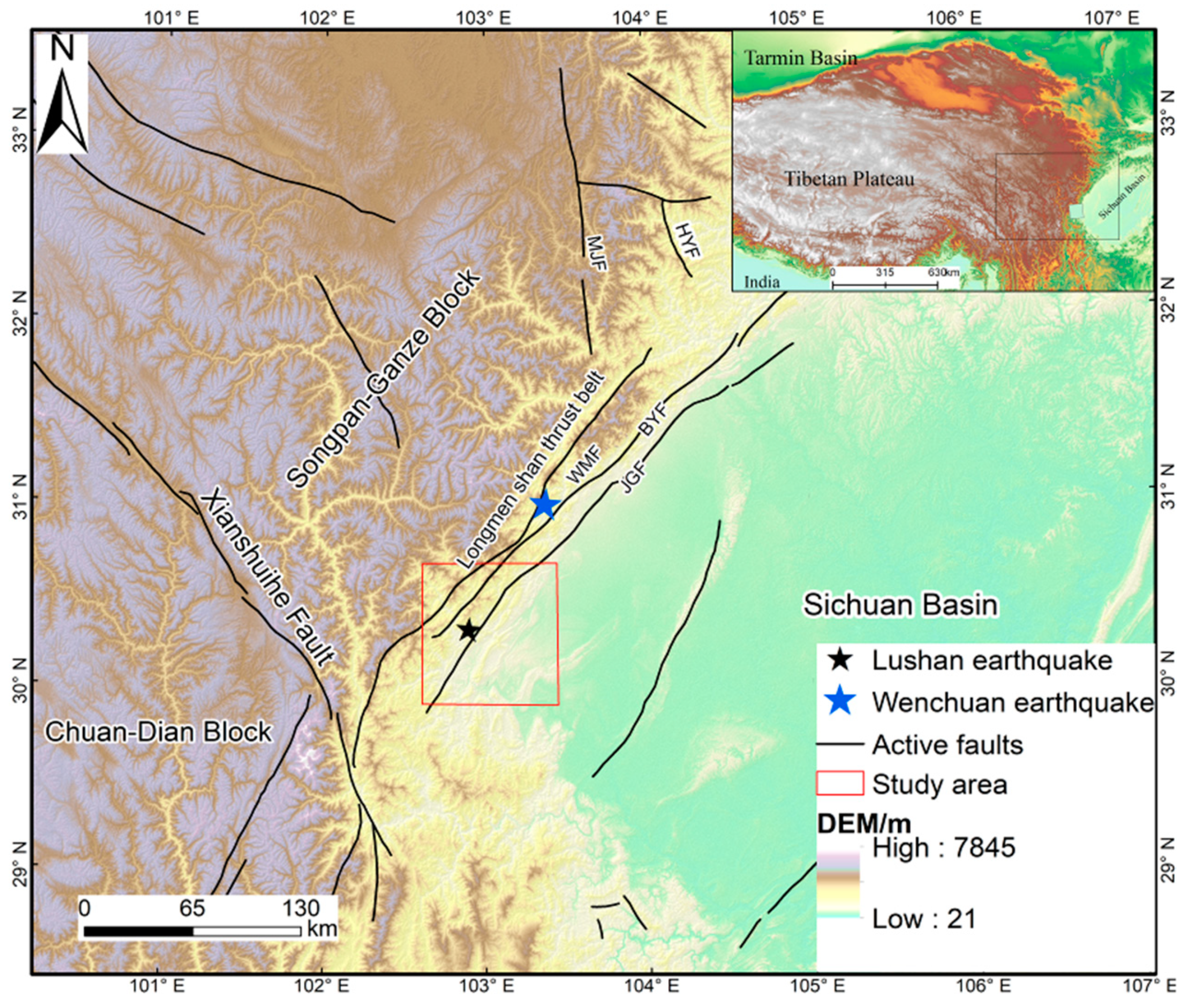
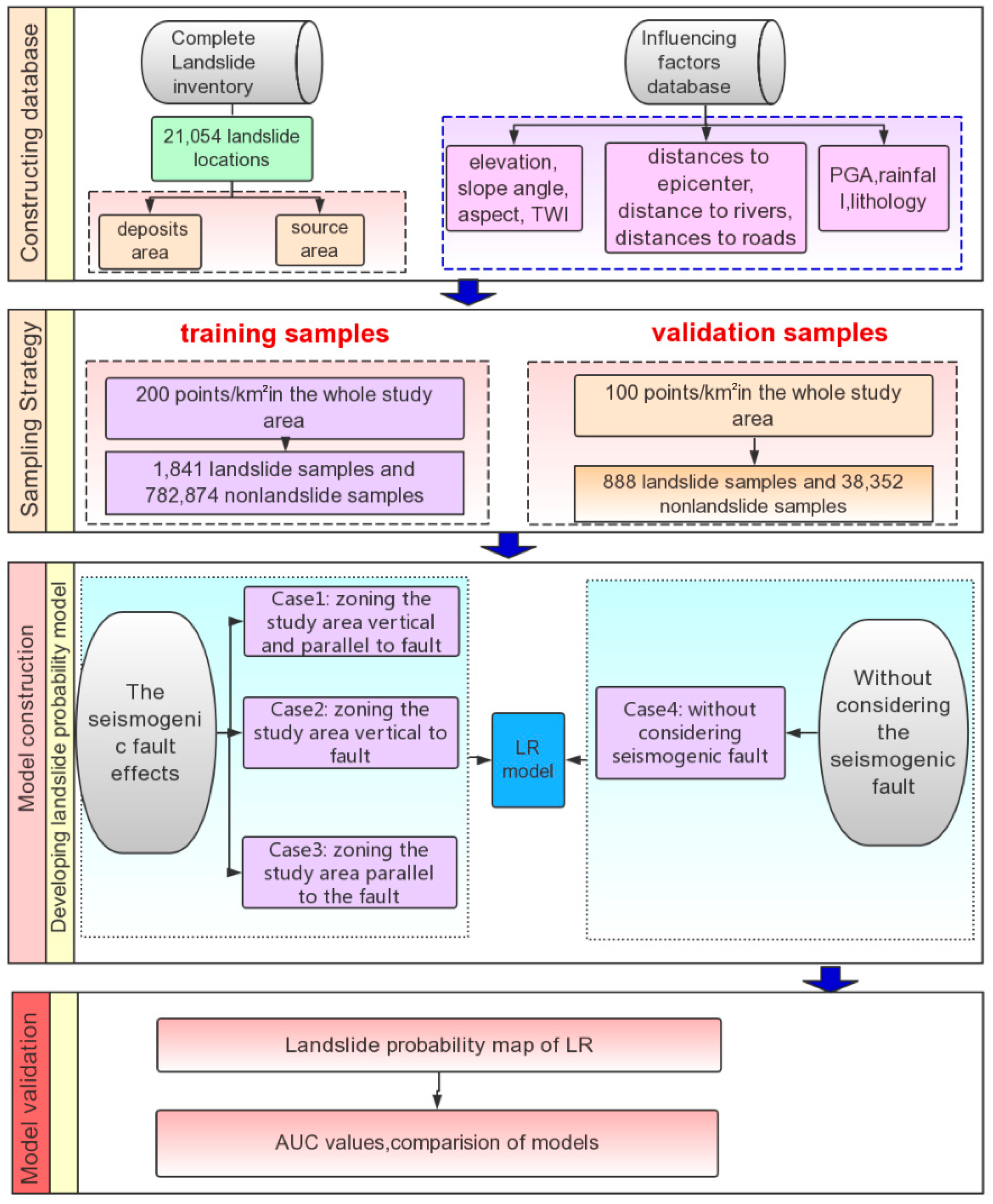


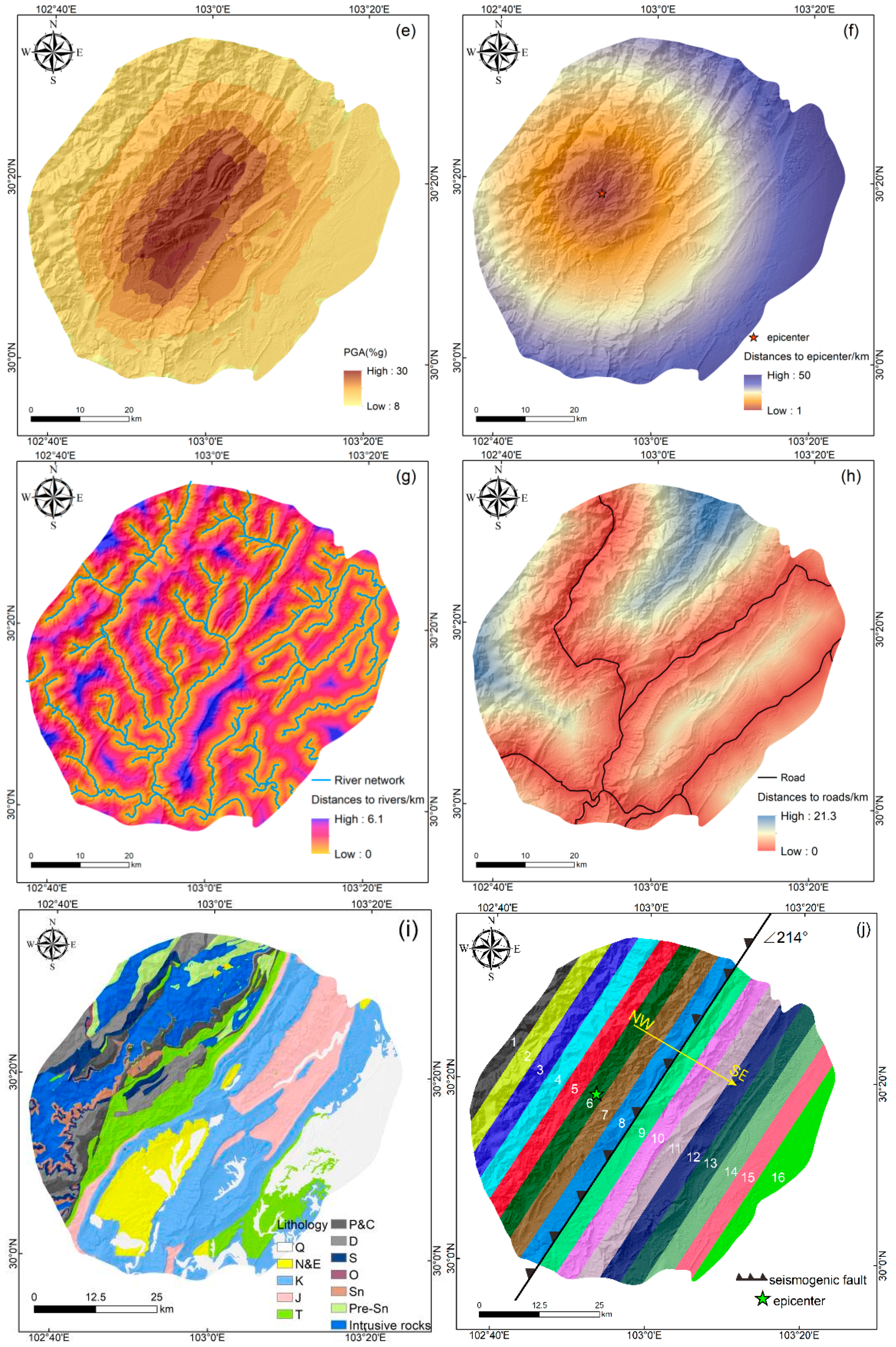
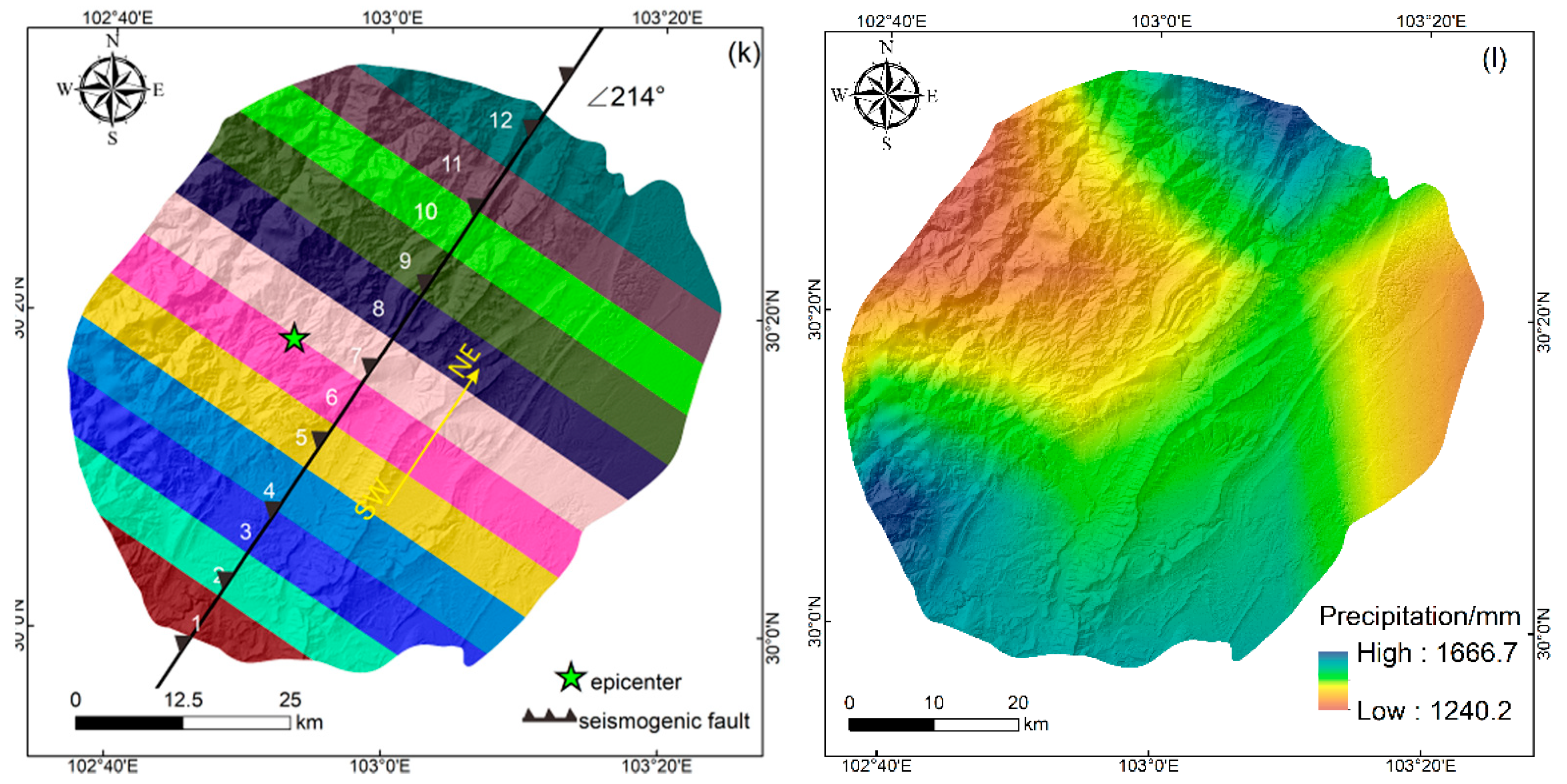
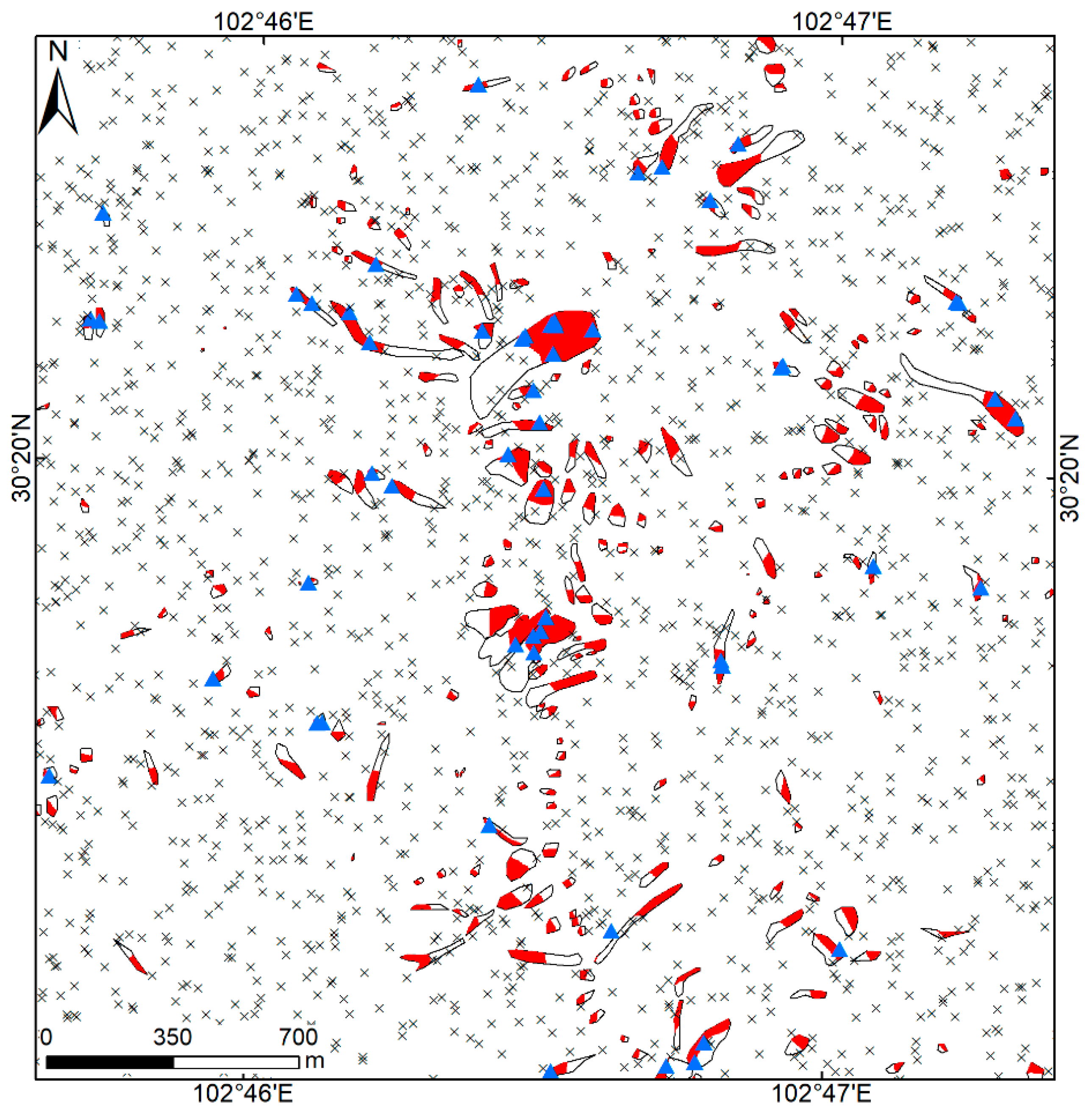
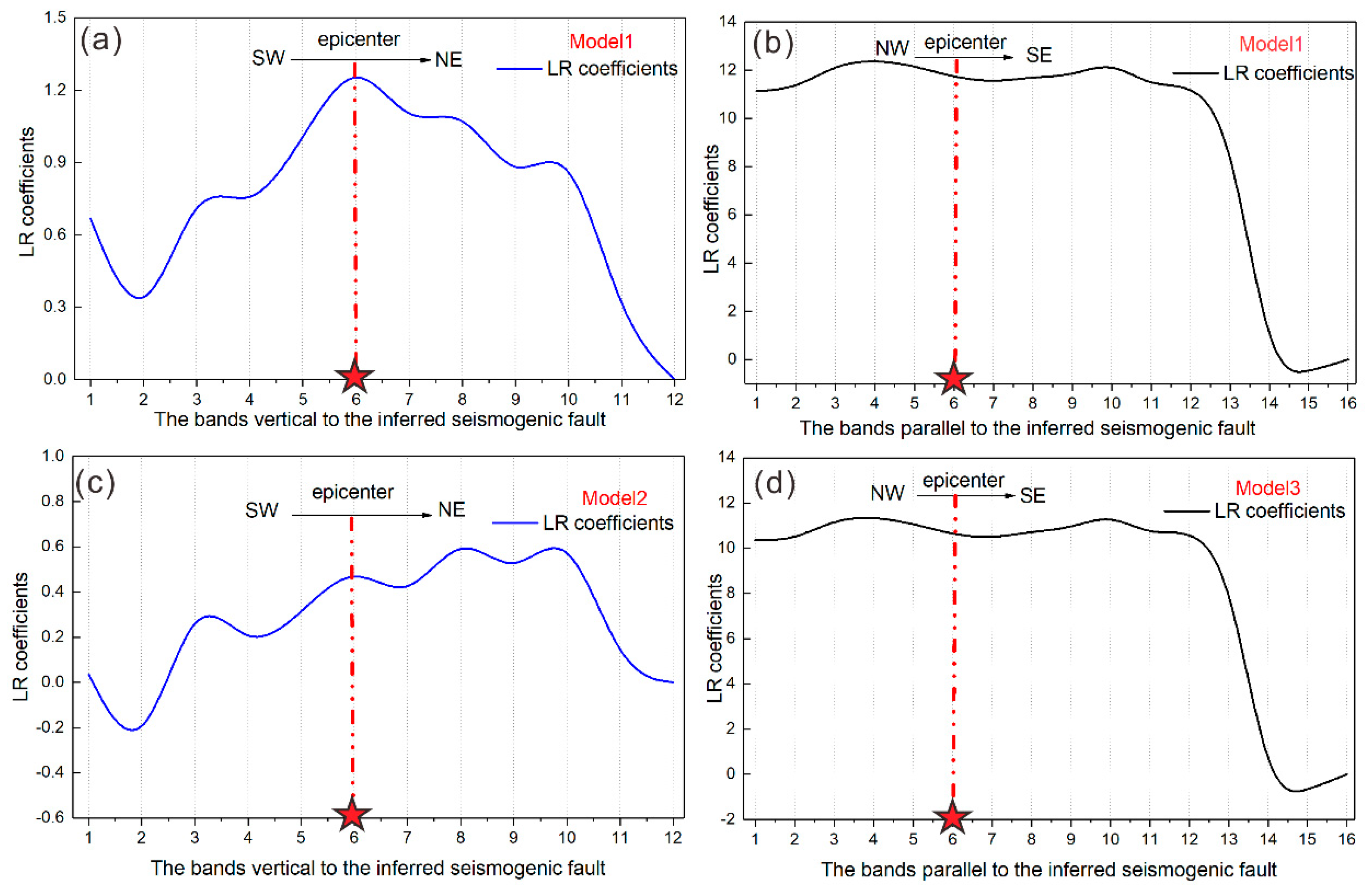
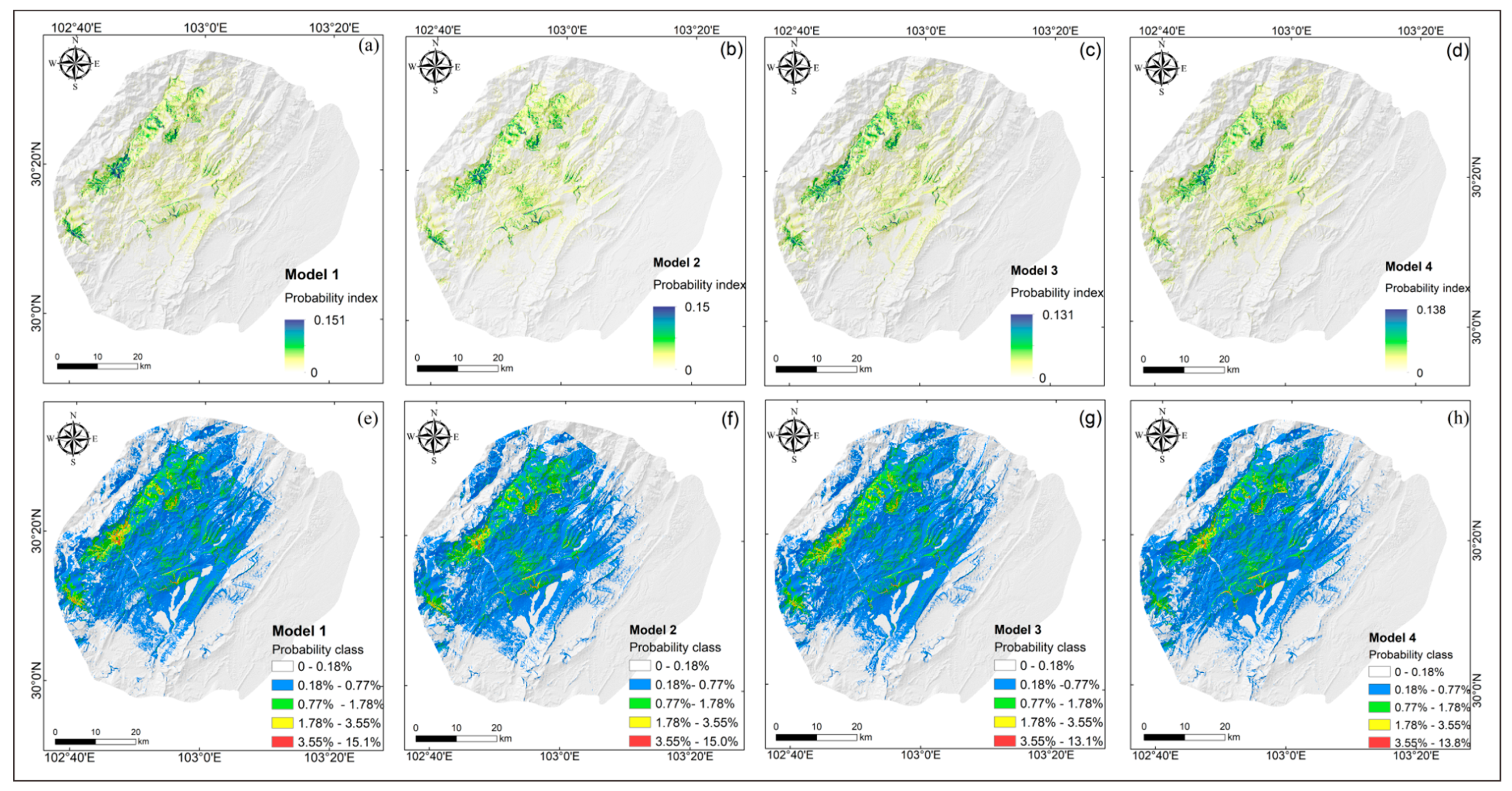
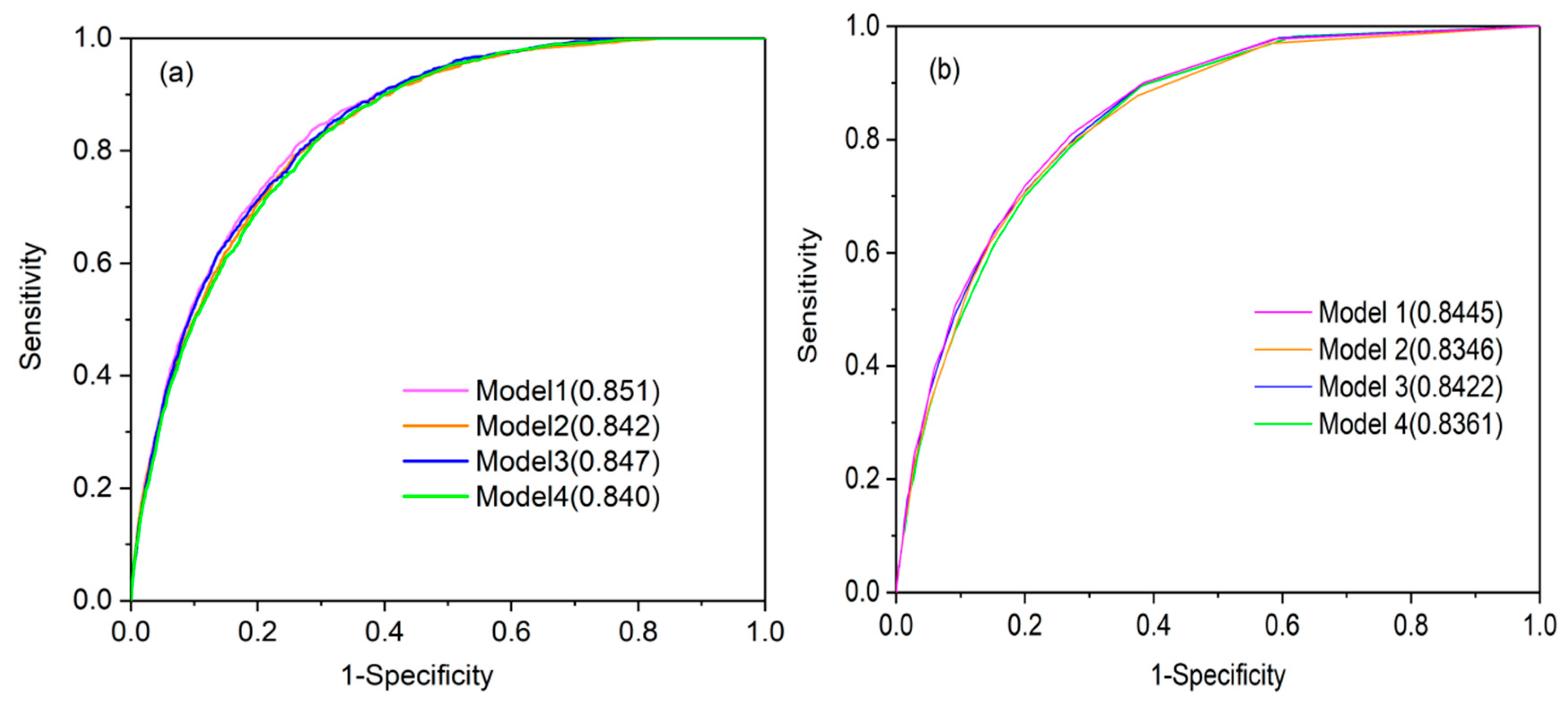
| Chi-square | df | Sig. | |
|---|---|---|---|
| Model 1 | 8.979 | 8 | 0.344 |
| Model 2 | 5.093 | 8 | 0.748 |
| Model 3 | 4.342 | 8 | 0.825 |
| Model 4 | 8.05 | 8 | 0.429 |
| Model (1) | Model (2) | Model (3) | Model (4) | |
|---|---|---|---|---|
| DEM | −0.000021 | −0.000013 | −0.000023 | 0.000043 |
| Slop angle | 0.051 | 0.068 | 0.066 | 0.069 |
| Aspect (1) | −11.393 | −11.562 | −11.382 | −11.570 |
| Aspect (2) | 0.276 | 0.254 | 0.278 | 0.251 |
| Aspect (3) | 0.440 | 0.401 | 0.442 | 0.392 |
| Aspect (4) | 0.231 | 0.188 | 0.229 | 0.182 |
| Aspect (5) | 0.128 | 0.086 | 0.133 | 0.090 |
| Aspect (6) | 0.107 | 0.058 | 0.119 | 0.061 |
| Aspect (7) | 0.168 | 0.135 | 0.174 | 0.141 |
| Aspect (8) | 0.080 | 0.079 | 0.079 | 0.075 |
| Aspect (9) | 0 | 0 | 0 | 0 |
| TWI | −0.031 | −0.018 | −0.032 | −0.016 |
| PGA | 0.074 | 0.043 | 0.076 | 0.060 |
| Distance to epicenter | −0.044 | −0.101 | −0.077 | −0.094 |
| Distance to rivers | −0.157 | −0.135 | −0.150 | −0.149 |
| Distance to roads | 0.039 | −0.010 | 0.032 | −0.012 |
| Lithology (1) | −2.477 | −3.006 | −2.632 | −3.096 |
| Lithology (2) | −0.866 | −1.205 | −1.022 | −1.338 |
| Lithology (3) | −1.187 | −1.422 | −1.287 | −1.472 |
| Lithology (4) | −0.905 | −1.094 | −0.982 | −1.053 |
| Lithology (5) | −1.001 | −1.498 | −1.116 | −1.561 |
| Lithology (6) | −0.843 | −0.962 | −0.931 | −1.012 |
| Lithology (7) | −1.378 | −1.698 | −1.504 | −1.776 |
| Lithology (8) | −1.463 | −1.666 | −1.520 | −1.707 |
| Lithology (9) | 0.110 | 0.147 | −0.004 | −0.001 |
| Lithology (10) | −0.742 | −0.704 | −0.858 | −0.809 |
| Lithology (11) | −1.233 | −1.337 | −1.289 | −1.388 |
| Lithology (12) | 0 | 0 | 0 | 0 |
| Rainfall | 0.003 | 0.006 | 0.003 | 0.005 |
| Constant | −24.350 | −14.453 | −21.568 | −12.261 |
| P-value Class | The Predicted Probability Area/km2 | The Observed Area Ratio of Landslides | ||||||
|---|---|---|---|---|---|---|---|---|
| Model 1 | Model 2 | Model 3 | Model 4 | Model 1 | Model 2 | Model 3 | Model 4 | |
| Very low (<0.18%) | 2418.85 | 2447.70 | 2413.31 | 2419.65 | 0.08% | 0.09% | 0.08% | 0.09% |
| Low (0.18–0.77%) | 1212.37 | 1191.06 | 1221.18 | 1213.86 | 0.65% | 0.68% | 0.66% | 0.68% |
| Moderate (0.77%–1.78%) | 238.54 | 237.24 | 237.03 | 242.88 | 2.12% | 2.04% | 2.13% | 2.02% |
| High (1.78%–3.55%) | 47.91 | 42.99 | 47.12 | 42.63 | 3.83% | 3.86% | 3.71% | 3.65% |
| Very high (3.55%–15%) | 6.26 | 4.93 | 5.28 | 4.90 | 5.96% | 6.48% | 5.73% | 5.90% |
© 2019 by the authors. Licensee MDPI, Basel, Switzerland. This article is an open access article distributed under the terms and conditions of the Creative Commons Attribution (CC BY) license (http://creativecommons.org/licenses/by/4.0/).
Share and Cite
Shao, X.; Xu, C.; Ma, S.; Zhou, Q. Effects of Seismogenic Faults on the Predictive Mapping of Probability to Earthquake-Triggered Landslides. ISPRS Int. J. Geo-Inf. 2019, 8, 328. https://doi.org/10.3390/ijgi8080328
Shao X, Xu C, Ma S, Zhou Q. Effects of Seismogenic Faults on the Predictive Mapping of Probability to Earthquake-Triggered Landslides. ISPRS International Journal of Geo-Information. 2019; 8(8):328. https://doi.org/10.3390/ijgi8080328
Chicago/Turabian StyleShao, Xiaoyi, Chong Xu, Siyuan Ma, and Qing Zhou. 2019. "Effects of Seismogenic Faults on the Predictive Mapping of Probability to Earthquake-Triggered Landslides" ISPRS International Journal of Geo-Information 8, no. 8: 328. https://doi.org/10.3390/ijgi8080328






